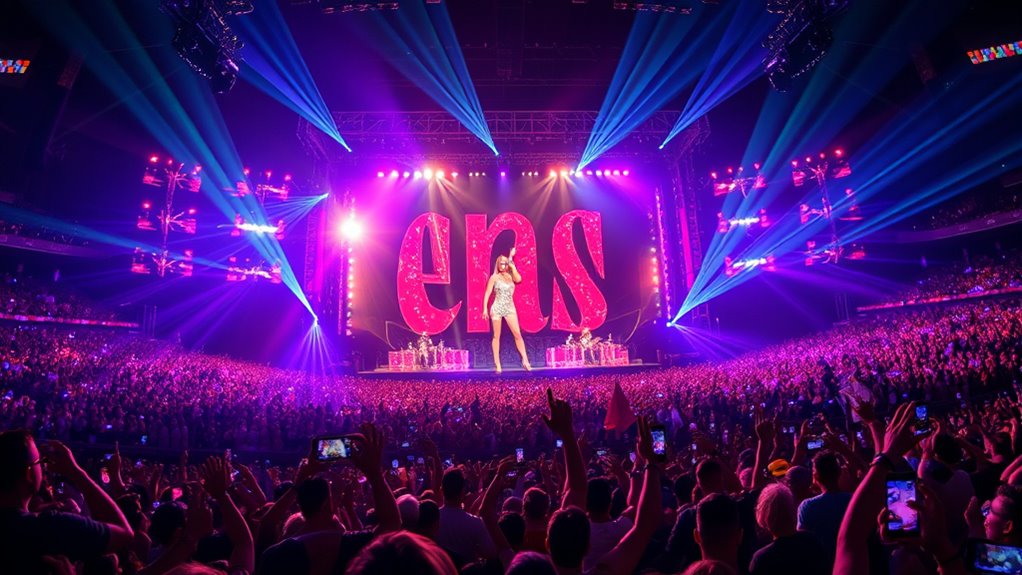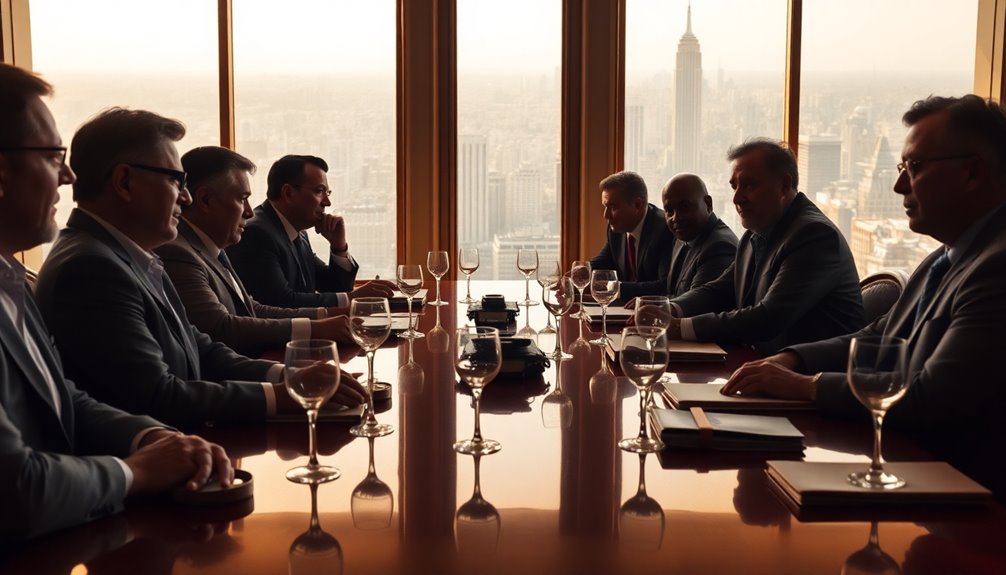Taylor Swift’s Eras Tour makes money through a mix of ticket sales, merchandise, sponsorships, and streaming rights. You’ll see revenue from ticket purchases, exclusive merchandise, and strategic partnerships, all coordinated to boost earnings. Merchandise sales at venues and online, along with seamless logistics, help maximize profits. If you want to discover how each element works together to create this billion-dollar phenomenon, keep exploring the details behind her successful tour.
Key Takeaways
- Ticket sales, streaming rights, sponsorships, and merchandise collectively generate the tour’s billion-dollar revenue.
- Merchandise sales, including limited-edition items, drive significant income both at venues and online.
- Efficient logistics and distribution ensure ample merchandise availability and smooth concert operations.
- Large venues and well-coordinated event planning maximize ticket sales and reduce operational delays.
- Seamless integration of ticketing, merchandise, sponsorships, and streaming contributes to the tour’s overwhelming financial success.

Have you ever wondered how a single artist can generate a billion dollars from a tour? It’s a combination of savvy planning, strategic revenue streams, and impeccable execution. When it comes to Taylor Swift’s Eras Tour, every detail is carefully orchestrated to maximize income, and two essential aspects stand out: merchandise sales and concert logistics. These elements are the backbone of her tour’s financial success, fueling her billion-dollar earnings.
Merchandise sales are a significant part of the revenue equation. Fans eagerly buy everything from T-shirts and hoodies to posters and exclusive collectibles. Taylor Swift’s team designs limited-edition items that tie into each era of her music, creating a sense of urgency and exclusivity. This approach boosts sales both at the venues and online, allowing her to capitalize on her fans’ loyalty and excitement. The logistics behind merchandise sales are complex; they require well-coordinated supply chains, strategic pricing, and efficient distribution channels. Swift’s team makes certain that merchandise is available in ample quantities without causing shortages or long lines, which can frustrate fans. They even set up dedicated merchandise booths at each concert, often with mobile units that can move to accommodate large crowds. This seamless integration of merchandise sales into the concert experience substantially adds to her tour revenue. Additionally, utilizing recognition of recurring numbers can help in tracking sales patterns and customer preferences.
Merchandise sales boost revenue through limited-edition items, strategic pricing, and seamless distribution at each concert.
Concert logistics plays an equally important role. Every aspect, from stage design and lighting to sound systems and crew coordination, must run smoothly to keep the show on schedule and ensure a memorable experience. Taylor Swift’s team invests heavily in planning this intricate dance, working with hundreds of professionals to fine-tune each detail. The logistics also include managing ticket sales, security, transportation, and accommodations for the touring crew. Efficient logistics mean more shows can be scheduled in a shorter time frame, increasing total revenue. It also enables Swift to host large venues, which maximize ticket sales and, consequently, concert income. The smooth operation of these logistics keeps fans happy, reducing delays and technical issues that could hurt her reputation or sales.
All these elements—merchandise sales and concert logistics—work together seamlessly. They allow Taylor Swift to deliver an unforgettable experience while generating massive revenue at each stop. When combined with ticket sales, sponsorships, and streaming rights, these factors contribute to her tour’s astonishing billion-dollar figure. It’s a masterclass in tour management and monetization, showing how every detail counts in turning a series of concerts into a monumental financial success.
Frequently Asked Questions
How Does Taylor Swift’s Team Negotiate Ticket Prices?
You might wonder how Taylor Swift’s team negotiates ticket prices. They use dynamic pricing, adjusting costs based on demand to maximize revenue and reduce ticket scalping. By setting prices strategically, they make tickets less attractive for scalpers and more fair for fans. This approach helps balance supply and demand, ensuring fans get access while protecting the artist’s profits. It’s all about smart pricing to keep the tour profitable and fair.
What Are the Main Costs Involved in the Tour?
You might think ticket sales cover everything, but the main costs involve meticulous cost management and logistics planning. You’ll spend big on stage design, costumes, and advanced technology, all to amaze fans. Travel, accommodation, and security also drain resources. Ironically, as you try to maximize profits, you realize how complex and costly touring really is, with every detail demanding careful planning and significant investment for a flawless show.
How Does Merchandise Sales Revenue Compare to Ticket Income?
You’ll find that merchandise sales often generate significant revenue, sometimes surpassing ticket income, thanks to your fan engagement and strategic merchandise planning. Your merchandise strategy, including limited editions and exclusive items, encourages fans to buy extra, boosting overall revenue. This approach maximizes your income streams, leveraging emotional attachment and brand loyalty, making merchandise sales a vital part of your tour’s financial success.
What Role Do Sponsorships Play in Tour Revenue?
You see sponsorships, like brand partnerships and advertising deals, play a vital role in tour revenue. They provide additional income beyond ticket sales, merchandise, and concessions. These sponsorships often involve companies paying for promotional opportunities during the tour, which boosts overall earnings. By leveraging these brand relationships, you increase revenue streams and enhance the tour’s financial success, making sponsorships a key component of a lucrative concert tour.
How Is Revenue Shared Among Concert Venues and Promoters?
When it comes to revenue sharing, you’ll find that concert venue profits typically come from ticket sales, concessions, and merchandise. Promoters usually take a commission from ticket sales before the venue receives its share. The promoter’s cut varies, but it’s a significant part of the overall revenue. You can expect the venue to earn its profits after deducting promoter commissions and operational costs, ensuring both parties benefit from the event.
Conclusion
So, as you see, Taylor Swift’s Eras Tour isn’t just a concert; it’s a well-oiled money-making machine that flows like a mighty river, fueling her empire and solidifying her status as a musical legend. Every ticket sold, merch bought, and streaming dollar adds to her billion-dollar success story. Just like a masterful conductor, she orchestrates her earnings perfectly, proving that with the right rhythm, you can turn a tour into a fortune that echoes for years to come.








